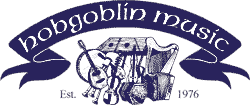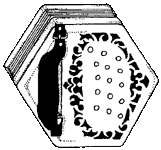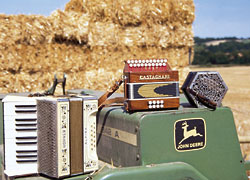
| THE HOBGOBLIN INFO SOURCE | |||
| HOBGOBLIN INDEX PAGE | HOBGOBLIN INFO INDEX | CATALOGUE CONTENTS | CONCERTINA ONLINE SALES | SECONDHAND PRICES |
| Concertina FAQ | ||
 |
ON THIS PAGE: Concertina History Concertina Makers Which System Do I Need? Choosing a Vintage Instrument RELATED PAGES: The Wheatstone English Concertina (96k) Wheatstone dating chart Care & Maintenance |
 |
|
© Copyright Hobgoblin Music 1983, 2000. This text may be freely distributed in whole or in part so long as the copyright holder is clearly acknowledged. Concertina HistoryThe concertina was invented by Charles Wheatstone, and the earliest examples, which he called the symphonium, were made in 1829. The general idea of the free reed instrument had been around for some time however, and in its earliest form, the Chinese Sheng, for thousands of years. At the time of the first concertinas, Harmonicas and Melodeons (or hand harmonicas) were already developing in Germany. Wheatstone's concertina was carefully designed to get the best out of the free reed system, and he published several scientific papers on the subject. Among other details, he established that a cylindrical shape would be most efficient, hence the six sided shape which approximates the ideal. Later 8 and 12 sided models got closer to perfection, Lachenal introduced the 12 sided Edeophone in 1890 and Wheatstones 8 sided Aeola came in 1901. All the early concertinas were English system ones, as designed by Wheatstone. His clever design gives the same range as a violin in a handy size, and it quickly caught on in the drawing rooms of Victorian England, where it was typically used to perform the classics. In fact a great deal of music, including concertos, was published specifically for the instrument. The development of the Anglo system, around 1850, has been attributed to George Jones, who is known for other advances, such as his broad steel reeds. It may well have been that he simply brought the idea back from Germany. The system combines the German push-pull note arrangement of the harmonica, with the handy size, and refined sound of the concertina, and was originally known as the Anglo-German system. This new system brought the concertina to the masses, with Lachenal and Co. producing around a quarter of a million units over the years, most of them Anglos, until the factory closed in the slump of the thirties. The German factories in Saxony also made enormous numbers of cheap anglos but not many of these were well enough made to survive. If Lachenal were the biggest concertina makers, then Charles Jeffries was considered to be the best, at least for Anglos. He had worked with Jones at one time, but soon he was producing superb concertinas, with reeds made from steel that seemed better than anyone elses. Charles Jeffries died in 1906, but his sons continued the business into the 1920s. Another concertina maker of note was Crabb, who started up about the same time as Jeffries, but whose company lasted the longest of all, sadly finishing in 1989 with the death of Neville Crabb. C. Wheatstone & Co stayed in business right up until the late 1960s latterly owned by Boosey & Hawkes. Coincidentally with the rise of the Music Hall for entertainment, the Duet system was developed and patented by Professor Maccann and licensed to Lachenal and later Wheatstone. This at last provided a concertina that a professional musician could get his teeth into! and was widely used by music hall artists. It separated the treble and bass keyboards, and allowed the left hand to play counter melodies that crossed over with the range of the right hand. Alexander Prince, probably the best known Concertina player of all, made many recordings on the MacCann system. Other Duet systems have been invented, most notably the Crane system, renamed the Triumph by the Salvation Army. The Salvation Army was an important supporter of the concertina, and supplied its members with a large number of instruments of all the major fingering systems, nearly always with a plain black bellows. Nowadays there are not many concertinas made in England, although after a short period of inactivity Wheatstone are making small numbers of concertinas as good as those of the past. John Connor has now established himself as a respected maker too. The biggest concertina makers are now based in Italy, where the Gremlin Roman range is made for us, and Chinese made anglos are beginning to appear.Concertina MakersJohn ConnorJohn Connor learnt his trade with Crabb's, and he has now developed and improved his methods to produce his current range of instruments which have a light and responsive touch, and a bright sound. His traditionally built instruments have a real feel of quality, and they play better than many of the well known vintage makes. We can get custom made models from Connor and Wheatstone but the wait time is often very long, and if a handmade concertina line becomes out of stock it can take several months to replace, so please enquire first. Gremlin Roman ConcertinasGremlin Roman models are ideal for most players, they all have light easy action, trouble free aluminium mechanism, generous leather bellows (except the 20 key Anglos), and well spaced, easy to reach keys, features calculated to help the learner gain confidence quickly, and the more experienced player to develop their skills. They are available in 20 and 30 key Anglo, and 12 key miniature, 30 and 48 key English. Gremlin Concertinas are built in the traditional accordion making region of Italy, home of all the best manufacturers, using high quality Swedish steel reeds, which are responsive, with a bright, clear sound. A.C. Norman & Gremlin, Ashdown, SherwoodBuilding on the foundations of a previous co-operation between us when we made over 100 "Gremlin Saxon" Concertinas in the early eighties, Andrew Norman came up with a significant improvement to that design, sold under both A.C Norman and Ashdown names. 30 key Anglos only at the moment, either in C/G or G/D. For a very reasonable price, you get fretworked metal ends, metal keys, handmade leather bellows, hand tuned Antonelli steel reeds, and a sound and response better than an old Lachenal. The Gremlin Sherwood Concertina draws elements from the original Gremlin Saxon the Norman/Ashdown and some new changes. Production of the Sherwood concertina started in the mid 90s and is currently paused WheatstoneWheatsone & Co. was founded by Sir Charles Wheatsone's father, before they started making concertinas. Charles Wheatstone died in 1875 but the company continued successfully. Always considered the premier maker of Concertinas, it was later owned by Boosey & Hawkes, and now by Steve Dickinson. The modern instruments are very good indeed, but there is a very long waiting list. SuttnerJürgen Suttner has been making good quality concertinas in his German workshops for several years, this is the first time we have been able to offer them for sale. We always have 30 key anglos in stock, or on order, but various other models are available, please enquire. Other MakersWe stock 20 key anglos made in China, these are basic but workable instruments. The Chinese also make 30 key anglos, but the quality isn't good enough yet. There are a number of small companies in Saxony making anglos, and the big company of the region Harmona still makes them too, but the prices don't compare well with the Italian made instruments. There are also workshops in Russia producing 20 key anglos in the style of the Italian models. Colin Dipper is the other leading English maker. His instruments are solidly built and have a reputation for quality. Again there is reputedly a very long waiting list. As the concertina revival continues, new makers are starting up, we now also know of Hamish Bayne in Scotland, making English system models, and Harold Harrington in the USA making Anglos. Which System Do I Need?Anglo SystemThe Anglo is commonly used for dance-music, particularly Morris, and Irish music. It's also used to accompany songs, shanties etc. Each button produces a different note on the push and draw of the bellows (so there are TWO notes per button). The high notes are on the right-hand end, the low on the left. So you can play the tune with the right hand, and vamp chords with the left. This system gives a much punchier, dance-type sound. C/G is the standard tuning found in all the books, and is popular in Ireland where the key of D is played across the rows. Listen to Noel Hill who plays this style. Bb/F is common in older instruments and is good for brass band work. G/D is rare in old instruments, but very popular nowadays especially with Morris musicians for its useful keys, and because of the deeper tone. Well known Anglo players include William Kimber, Scan Tester, and John Kirkpatrick. It may be of interest to note that in South Africa there is a tradition of using a two voice 20 key anglo, the voices an octave apart. The concertina is also played a little in South America, probably rather like the bandoneon. English SystemFor each button, the same note plays on the push and pull of the bellows. It is fully chromatic. On a 48-key Treble instrument, the range is similar to a Violin from G to C three and a half octaves above. The scale is played by alternating between the ends, which makes it easy to play fast runs. Block chords are easy to build up, and the English Concertina is excellent for song accompaniment. The Tenor extends the range down to C, but loses the upper range, the Tenor treble covers the whole range from C to C, and the Baritone has a range one octave below the Treble. Well known players of this system include Alf Edwards, Alistair Anderson, John Townsend, & Damien Barber.Duet ConcertinasProbably the hardest to play, but the most versatile. Like the English, the same note plays in both directions, but like the Anglo, the treble notes are on the right hand end, and the bass notes on the left. There are three common types of Duet, all with a different keyboard layout, MacCann, Jeffries and Crane (or Triumph), as well as the more recent Hayden system. We have secondhand duets in stock at all times, but new ones are only available to order. Two well known players are Alexander Prince (MacCann), & Tim Laycock (Crane)How to choose a Vintage ConcertinaLachenal made about 250,000 concertinas, and Wheatstone 35,000, and since they were never cheap instruments most people held on to them, and many of them survive today. The relatively good supply of old instruments means that many players will choose a secondhand instrument rather than a new one, but it can be very difficult to spot the differences between them without experience. Hopefully this section may help a little.DIFFERENT SYSTEMSFirst make sure which fingering system you are looking for, Anglo, English or Duet, see above for an explanation. The reeds are the next most important thing, brass is softer, and needs more tuning, while steel is longer lasting and faster to speak. Unless you have a small budget, or have a quiet singing voice, steel is probably best. The bellows should be big enough to play smoothly, and it shouldn't leak. 5 folds is good enough for English and Duet, 6 is better for Anglo because it needs more air. Watch out for the tuning because most concertinas were not made in concert pitch, and will need re-tuning before use. We always sell at concert pitch, unless otherwise stated.DIFFERENT MODELSThe most basic instruments are Lachenals, with simply fretworked wooden ends, and bone keys. An Anglo of this quality will have at least 20 keys, and as many as 30. An English system one will always have 48, coloured white, black for half notes, and red for C. They generally have brass reeds, but there are some with steel, especially those with rosewood rather than mahogany ends, so check. I have heard it said in other Concertina FAQs that dealers don't let you check inside their instruments. Personally I have never come across this, and at Hobgoblin Music we have always allowed our customers to check instruments as thoroughly as they like before buying. If you are either not technical enough or not bothered to check, you would be well advised not to buy privately without an expert in tow, I have heard many tales of would be players ending up with unsuitable or unplayable boxes. Jones made some quite good Anglos with mahogany ends, and there were better quality student English concertinas made earlier, by Wheatstone, Louis Lachenal, Rock Chidley, George Case and others. These have rosewood ends, bone keys, and brass, or nickel silver reeds. These latter can be easily confused with steel, but they play more like brass. These early examples have a more muted sound, often with a wooden baffle to hide the action. The next range of instruments have a more intricate fretwork pattern and nearly always steel reeds, Lachenals made a lot of Anglos like this, and some Duets and Englishes. They play very well usually. Anglos are rare with rosewood ends and metal keys, but there are a lot of English and Duet ones, and again they usually play well. There are some with brass reeds, but these are much better than the cheap ones, and their softer tone can be useful. The Wheatstone ones have the best action, and examples by Lachenal and Case sometimes have brass inlay, and fancy bellows papers, known as the Excelsior model. Similar instruments with ebony ends are also found. Another enhancement is metal end plates, this adds to the brightness and volume. Lachenal made a few with bone keys, but metal is usual. The makers seem to have put better reeds in most of the metal ended ones, and these command a higher price than the wooden ended ones. The flat metal ended Wheatstones are particularly fast and loud, especially the Anglo which is thought by many to be the best. Jeffries, Crabb, and all the clones like Shakespeare, Ball Beavon and many unmarked ones are basically similar. Generally with flat metal ends, metal keys, riveted action, often embossed bellows, and good steel reeds. They only seem to have made Anglos in this style, and Jeffries is clearly the best. All Jeffries's have the maker's name stamp. The number of keys varies from 26, to the mid forties. A 30 key has enough keys for most needs, and usually sounds best. Jeffries also made models with raised endplates, both Anglo and Jeffries system Duet. Professional quality Englishes and Duets by Lachenal and Wheatstone are found with raised ends, metal or sometimes glass keys, and good long scale reeds. All play well, but the tone varies according to the design and materials. The best examples are the multi sided variants, Lachenal's Edeophone with 12 sides, and Wheatstone's Aeola with 8.Back to the Top of the Page This page is maintained by Pete McClelland Last modified on 21/06/99 |